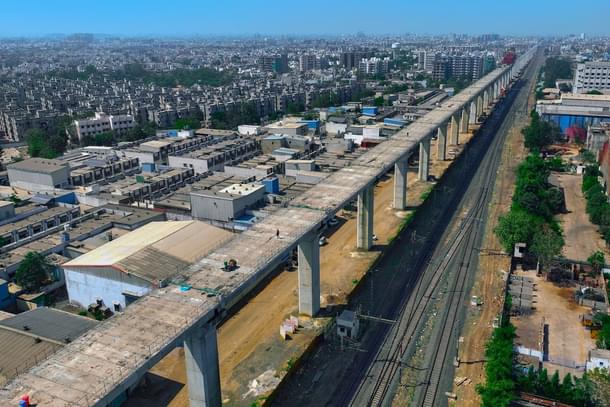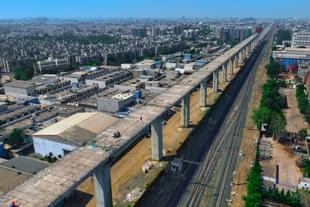Infrastructure
Mumbai-Ahmedabad Bullet Train Corridor Fitted With 175,000 Advanced Noise Barriers So Far
V Bhagya Subhashini
Sep 11, 2024, 10:53 AM | Updated 10:53 AM IST
Save & read from anywhere!
Bookmark stories for easy access on any device or the Swarajya app.


In a significant milestone for the Mumbai-Ahmedabad bullet train project, the National High Speed Rail Corporation Limited (NHSRCL) announced that the installation of noise barriers along the bullet train corridor is progressing rapidly.
These barriers are crucial to mitigating the noise generated by the high-speed train and its infrastructure during operations.
According to NHSRCL, as of 10 September, noise barriers have been installed over a stretch of 87.5 kilometres in Gujarat. Over 175,000 individual noise barriers have been placed so far. For every kilometre of the corridor, 2,000 noise barriers are being installed on both sides of the viaduct.
Inspired by Japanese Shinkansen technology, these barriers consist of 2-metre high and 1-metre wide concrete panels positioned along both sides of the viaduct.
These noise barriers are strategically designed to reflect and disperse aerodynamic noise generated by the train, as well as noise from the lower part of the train, particularly from wheels interacting with the tracks. Importantly, they are engineered not to obstruct the scenic views enjoyed by passengers during their journey.
Segments of the viaduct passing through residential and urban areas will feature taller noise barriers, reaching up to 3 metres in height. These enhanced barriers include an additional 1-metre layer made of translucent polycarbonate, ensuring effective noise reduction without compromising visibility, reports Hindustan Times.
NHSRCL stated that the manufacturing of these modular noise barriers is being carried out at three precast factories located in Surat, Anand, and Ahmedabad.
Internally, the bullet train’s double-skin aluminium alloy body minimises noise levels for passengers. Additionally, its streamlined nose design significantly reduces aerodynamic drag, thereby mitigating the loud sounds produced by micro-pressure waves as the train exits tunnels.
Of the total 508 km Mumbai-Ahmedabad High-Speed Rail (MAHSR) alignment, more than 465 km is elevated on viaducts.
India’s First Bullet Train Project
The high-speed rail operating at 320 kmph will traverse between Mumbai and Ahmedabad in just about two hours.
It will cover 155.76 km in Maharashtra, 4.3 km in the Union Territory of Dadra and Nagar Haveli and 348.04 km in Gujarat, with 12 stations en route. There are eight stations in Gujarat (Sabarmati, Ahmedabad, Anand, Vadodara, Bharuch, Surat, Bilimora, and Vapi) and four in Maharashtra (Boisar, Virar, Thane, and Mumbai).
NHSRCL plans to operationalise the section between Vadodara and Vapi by 2027, aiming for complete project delivery by the second half of 2028.
In September 2017, Prime Minister Narendra Modi and his Japanese counterpart Shinzo Abe laid the foundation stone for the high-speed rail project at Sabarmati in Ahmedabad.
V Bhagya Subhashini is a staff writer at Swarajya. She tracks infrastructure developments.





